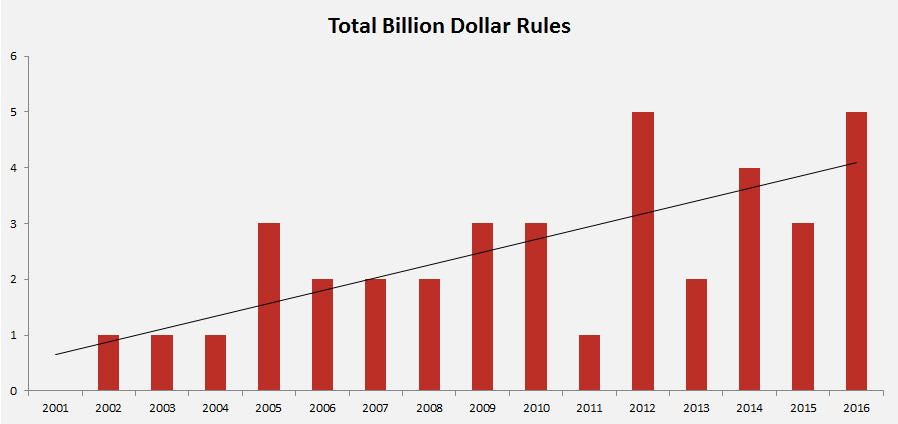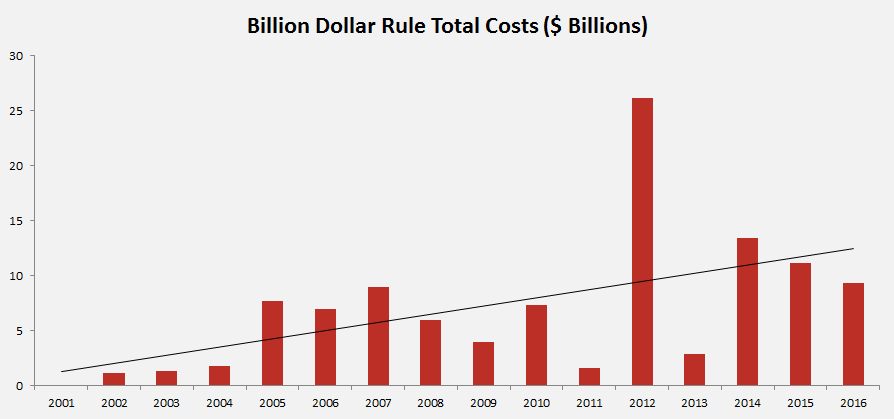Insight
November 22, 2016
A Review of High-Impact, Billion-Dollar Rules
Every year regulators issue thousands of regulations. A handful impose costs exceeding $100 million annually. For example, in 2016 regulators have published 47 rules with annual costs eclipsing $100 million, totaling $20.9 billion in total costs. However, billion-dollar, high-impact (“mega rules”) are typically an aberration. During the Bush Administration, there were an average of 1.6 per year. The Obama Administration has now pushed the average to more than 3.25 annually. The Bush Administration, over the span of 8 years, published $35 billion worth of mega rules; the Obama Administration imposed $42 billion, from 2012 to 2014 alone. With a few months left to regulate, President Obama has already imposed roughly $75 billion in annual mega rule costs, with a net present value burden of $424 billion, or $1,300 for every person in the U.S. In other words, this is the per capita burden from just 25 rules.
The chart below tracks the trend in the number of mega rules since 2001 (when there were zero).
There were zero at the start, to highs of five mega rules in 2012 and 2016. From 2001 to 2008, there were a total of 12 billion-dollar regulations. From 2009 to present, there have been 26, including a pending proposed rule from 2015. In other words, President Obama has managed to more than double the output of mega rules, with a few months left to regulate.
The chart below examines the aggregate annual costs of these measures. For example, in 2002, there was just one mega rule, imposing $1.1 billion in costs. By contrast, in 2012, there were five billion-dollar regulations, imposing $26.1 billion in costs.
It’s striking that President Bush’s total of $35 billion was easily exceeded between 2012 and 2014, when mega rules generated more than $42.4 billion in annual costs. Thus, it’s not just the pace of high-impact rules, it’s the magnitude. In broader terms, there have been more than 101 rules during this time with total costs exceeding $1 billion, not simply annual costs.
Which agencies have implemented mega rules most often? During the Obama Administration, the Environmental Protection Agency (EPA) is responsible for nine of the 25 billion-dollar rules, totaling $44.3 billion or 59 percent of the administration’s total. Given passage of the Affordable Care Act, the second-place agency should come as no surprise. Health and Human Services (HHS) issued four mega rules, yielding $7.7 billion in costs or 10 percent of the administration’s total. Six other agencies imposed at least two mega rules during this period.
By specific rule, EPA measures have also resulted in the highest total burden figures. The three most expensive billion-dollar rules since 2001 were all from the Obama Administration’s EPA: 2017 to 2025 CAFE Standards ($10.8 billion), the Mercury and Air Toxics Rule ($9.6 billion), and the Clean Power Plan ($8.4 billion). In fact, EPA has the top five most expensive measures; the other two in the top five were from the Bush Administration, however: Fine Particle Implementation Rule ($7.9 billion) and Standards for Particulate Matter ($5.4 billion). Combined, these five rules have imposed $42.1 billion in annual costs or roughly 38 percent of the total cost of mega rules.
Reform?
The trends indicate billion-dollar rules are increasing in both frequency and magnitude. Policymakers have started to take notice. There are two legislative vehicles that would address mega rules. They would not necessarily end the federal government’s ability to implement large rules, but they would place them under more scrutiny.
The “Review Act,” sponsored by Representative Tom Marino, defines a “high-impact rule” as a measure that imposes at least $1 billion in regulatory costs. Once an agency promulgates a high-impact regulation, it must postpone the effective date pending judicial review. However, the rule will take effect 60 days after publication if no one seeks litigation. This legislation is designed to address instances when a court will strike down a regulation several years after it is first published. Although plaintiffs might win on the legal merits, sunk regulatory costs can make winning in court a pyrrhic victory. If the Review Act becomes law, regulated entities will only have to bear significant costs after courts agree that the law passes constitutional or statutory muster.
The second major legislative approach, the Regulatory Accountability Act (RAA), introduced by Representative Bob Goodlatte, has passed the House several times since its introduction. It also creates the definition of “high-impact” for billion-dollar rules and ensures that agencies must take the initial step of publishing an advanced notice of proposed rulemaking for these mega rules. During the Obama Administration alone, regulators have published 64 economically significant measures as interim final rules, without first soliciting public comment.
The RAA also requires agencies to hold hearings before adopting these high-impact rules and to follow the Information Quality Act. The agency must also have a plan for reviewing these regulations every ten years to determine if, “there remains a need for the rule.” Again, the Review Act and RAA wouldn’t slow the growth or magnitude of billion-dollar rules, but they would increase public transparency and judicial scrutiny.
Conclusion
In general, the regulatory world is top-heavy, where burdens are disproportionally imposed by just a handful of rules. Under President Obama, billion-dollar rules account for 52 percent of all regulatory burdens, in the context of more than 27,900 final rules. Currently, a rule with an economic impact of $100 million or more is considered a “major rule.” President Obama has issued more than 600, but there is no official government definition for regulations that clear the $1 billion threshold. Perhaps the trend toward more billion-dollar rules, 25 from President Obama imposing $75 billion in new annual costs, demands a more formal oversight tool for these high-impact regulations.













